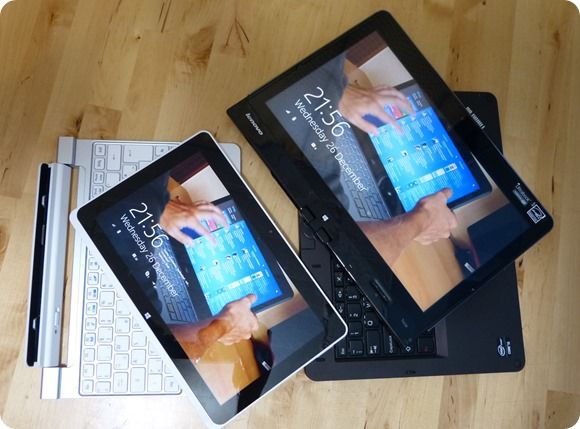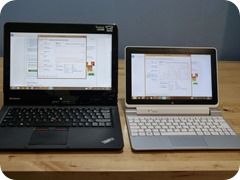
We focus on Ultrabooks here but also keep a close track on what’s happening in the ultra mobile PC space through our work with UMPCPortal. For some people it’s more important to be mobile with all-day, all-scenario capability at the expense of processing power or speed. For others, the most important thing is to be able to carry desktop power and that’s where a Core-based Utrabook comes in. But how big is the difference in platform performance? I’ve had a Atom-Clovertrail based tablet convertible for a few weeks now and so I took the chance to test it alongside an Ultrabook convertible – the Lenovo Thinkpad Twist. Both devices have strengths, and weaknesses.
Before you check out the video there are a few things to note. Firstly, I’m not testing form factors, mobility or battery life here
Secondly. it’s important that customers always find a device that fits 100% or more of their needs. Having a device that “does 90% of what I need” is a device that fails on 10% of the tasks you want to do on it.
This video presentation is an attempt to see what happens when you put a hybrid hard-drive Core-based device up against an SSD-Atom based device in terms of application usage. I haven’t compared a large sample of CloverTrail and Ultrabook devices here but the application test results are quite representative of what you’ll find across the board in my opinion. I haven’t done much in terms of GPU-intensive comparisons.
- Boot up speed comparison. (See this section on the video)
- Application start-up times. (See this section)
- YouTube performance comparison (and the effects of Wi-Fi performance) (See this section)
- Discussion and demo on the importance of a strong Wi-Fi subsystem. (See this section)
- Sunspider performance. (See this section)
- Intel Quick-Sync video editing comparison. (See this section)
- CPU-based video rendering comparison. (See this section)
- 720p playback CPU load test. (See this section)
- Windows 8 application start-up (where the devices are very evenly matched) (See this section)
- Unzip operation (Where the Core-based system provides a huge, huge real-world advantage) (See this section)
- Microsoft Office usage (see this section on video)
You won’t be surprised that the Core-based system wins most of these tests but there are some areas where the differential is quite small. Many Windows 8 applications, for example, don’t get much benefit from having Core over Atom due to their ‘quick-snack’ nature.
I haven’t mentioned ‘Connected Standby’ either which is a massive difference in the way these PC platforms work. The CloverTrail devices can’t hibernate or standby at all, they just turn the screen off and go into a quiet mode where Windows 8 apps are poling, audio apps can stream and Wi-Fi is still on. It results in many days of background tasking which means applications like Skype, email and Twitter can continue to update and notify. Clovertrail devices are ready as soon as you press the ‘power’ button. Core-based devices, on the other hand, require waking from a sleep state where nothing functions in the background. A 5-second reconnect is then followed by a rush of activity from applications to get their internet updates.
Clovertrail devices are smaller and lighter too so combined with the always-on feature, are more suited to on-the-road activities. With the W510 you’ve even got a lightweight tablet that’s detachable.
We could talk about the lack of USB3.0 or SATA, GPU and security features but for this article, let’s get back to applications performance so you can see just how big the differences are. The video is long, but worth a watch if you’re interested in the difference between current Atom and Core-based systems.Click on the links above to hop direct to a specific section of the video.












Very nice (and rare) video comparison of i-Core vs Clovertrail-Atom. This WILL help people decide what they want.
Thank you Chippy, and happy new year.
I guess I’m an impatient person. After seeing this video, I won’t be able to live the slow and stuttery performance of Clover Trail due to being used to using Core based notebooks with SSDs.
Windows 8 Modern UI apps (don’t know what they’re called now) may be okay right now but as they become more complex and hopefully they do (unlike Android and iOS) that gap will widen. Then again, when that happens, that new Atom architecture may be out.
Been using a Vivo Tab Atom powered tab for about a month and it works for me, doesnt feel slow or stuttery at all. One thing that could be affecting performace is drivers, so far thats been the biggest problem with these new Atom devices, at least with the Asus.
However I am not using it for real intensive tasks and with remote desktop to a more powerful PC it suffices for pretty much everything else but I really havent felt the need for more power yet. But I am also looking forward to the next gen of CPU’s, either Haswell or Atom cos you can never have enough speed! That will definitely make the choice more difficult.
Chippy,
I’m curious if you could check out a couple things on the w510 that ive encountered with the ones ive had.
First, see if you can actually boot from an external device connected via USB? I have the 32gb model and have been unable to get this working. Tried bootable usbs (lock up at start), external dvd (ignored at boot, readable after), external dvd on powered hub (locks up at start). Tried recovery dvds, windows XP boot disks. Acer support reads from a script and has no clue, played with them for a week.
Second, available free space. The first one I had after applying windows updates had 14.2gb of free space. I exchanged it hardware issues and the new one only had 10.2gb after installing windows updates. I did a disk cleanup that got it to 12.1gb. Still a far cry from 14.2 for an identical machine getting windows updates 1 day apart.